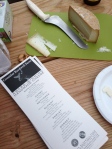by Alifair Skebe

Classic Burrata by Maplebrook Fine Cheese Bennington, Vermont
The first of the heirloom tomatoes are ripening on the vines. The luscious red clusters are ready to pick. What better to pair them with than the delectable cream-infused mozzarella “burrata,” fresh basil, and crusty bread?
Burrata has been recently coined “the new brie,” “the meta-mozzarella,” or “the postmodern version of mozzarella.” An invented tradition, this cow’s milk cheese (originally made from the milk of Podolian cattle) is a variant on the pasta filata (or stretched curd) mozzarella and filled with the tender, creamy scraps left over from the cheesemaking process. Its name refers to the “buttery” salted fresh cream curds inside its thin skin. Originated nearly 80 years ago and made in Apulia and Basilicata of Southern Italy’s Puglia region, burrata is difficult to find outside of Italy; it is literally a farm to table cheese, produced and eaten the same day.
Saving the cheeselover the cost of air-freighting and still offering the old-world tradition in North America, some fine U.S. farmstead and artisanal cheese producers have begun to make the cheese at home. Maplebrook Fine Cheese of Bennington, Vermont recently hired the Italian cheesemaker Domenico Marchitelli, who has been making the cheese for 25 years in Puglia. His Maplebrook burrata was named one of the top five cheeses of 2011 by Food & Wine editor Kristin Donnelley who writes: “Burrata is like the molten chocolate cake of cheese…this Vermont version, made by a Puglian cheesemaker, is as good as it gets.” The Cheese Traveler is excited to announce that we just got in a few of these lovely cheeses, and they are available for purchase at market.
Slicing open a burrata, the creamy center begins to spill out like a double or triple cream cheese, but the texture and flavor are like none other. The texture is soft, delightfully fragrant and light on the palate. At one time a purely economical cheese because it used what had been considered the “waste” of the process, burrata is now highly sought after and prized for its uniquely decadent taste, mouthfeel, and rarity.

Cheesemaker in Italy holding a burrata pouch ready to be filled
Mr. Marchitelli of Maplebrook “does not believe in sacrificing old world techniques in his cheesemaking.” To make burrata, the curds from the mozzarella-making process are recycled into a fresh, salted cream and poured into a little mozzarella pouch, then closed and wrapped in asphodel, a native wildflower. New Jersey poet William Carlos Williams immortalized the flower in the modern imagination:

Italian Asphodel
Of asphodel, that greeny flower,
like a buttercup
upon its branching stem-
save that it’s green and wooden-
I come, my sweet,
to sing to you.
More often today, you will find the cheese wrapped in plastic or preserved in salt brine. In early 2011, cheesemaker Richardo Olanda of Andria, Italy took viewers on a tour of his family’s cheeseworks in CIANetwork’s video feature “Burrata: Puglia’s Molten Mozzarella.” You can see how Olanda makes the cheese here. Compare this to Domenico Marchitelli’s process here. For a step-by-step description of the entire burrata-making process, check out Serious Eats‘ article from the series “Snapshots from Italy” by correspondent Carey Jones.
After you have purchased your burrata from The Cheese Traveler, consider this fine recipe for “Caprese salad with Burrata” served at the Wine Bar in Chicago’s Lincoln Park. (You can substitute the dried tomatoes for garden or farm-fresh ones!)
Vintage 338′s Caprese salad
Chef Blaze Correia
1/4 burrata cheese ball
3 ounces mesclun mix
2 tablespoons extra virgin olive oil
Salt and pepper to taste
2 ounces diced fresh tomatoes
1 ounce sun-dried tomatoes, cut in matchsticks
1/2 ounce fresh basil leaves, cut in matchsticks
2 tablespoons balsamic reduction
Chopped fresh parsley (optional)
In a bowl toss mesclun mix with half the olive oil and salt and pepper to taste. Arrange on a plate.
Top with diced tomatoes, cheese. Throw a pinch of salt and pepper on top and drizzle with the remaining olive oil. Add the sundried tomatoes and basil. Drizzle the balsamic reduction either over the entire plate or on the side. Garnish with chopped parsley. 1 serving.
Balsamic reduction
1 liter aged balsamic vinegar
1 tablespoon sugar (optional)
In a saucepan over high heat, bring the balsamic vinegar to a boil, then turn down the heat to medium-low and simmer. Stir to prevent from burning or scorching. Cook down by half or two-thirds until the vinegar is syrupy and coats the back of a metal spoon.
As the vinegar reduces it will naturally sweeten. If you wish it to be sweeter, add the sugar during the cooking process, stirring until it dissolves.
Pour ice and cool water into a bowl. Remove the reduction from the heat and pour into a squeeze bottle, secure top, and place in the ice bath. After about 20 minutes, the reduction will thicken and be ready to use. Makes 1/3 to 1/2 liter.
Sources:
Jenkins, Steve. Cheese Primer. New York: Workman Publishing, 1996, p. 252.










